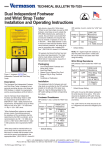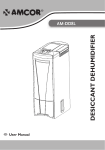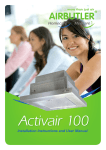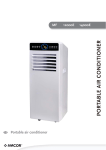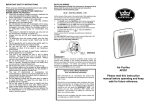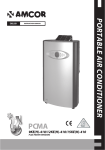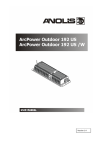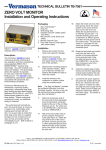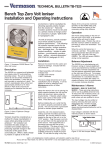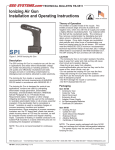Download Overhead Zero Volt Ioniser Installation and Operating Instructions
Transcript
TECHNICAL BULLETIN TB-7529 Overhead Zero Volt Ioniser Installation and Operating Instructions Made in America Installation Remove the ioniser from the carton and inspect for shipping damage. Included with the unit are: 1 Overhead Ioniser, Item 200300/200305 1 Keys (to power on) 1 Hanging Kit 1 Certificate of NIST Calibration The AC input voltage should be set to the user's specification prior to shipping (220v). It can be verified or reset by referring to the Maintenance / Cleaning section of these instructions. Figure 1. Overhead Zero Volt Ioniser Description The Overhead Zero Volt Ioniser combines the effectiveness of steady-state DC ionisation with ease of adjustability, communication capability, and the flexibility of a microcontroller based design to produce a versatile and stable ionisation system. Three fans produce extended ionisation coverage, and are ideal for areas where bench space is limited. (Note: for the 2 fan unit, disregard any instructions relating to the 3 fan unit or fan 3. Optional network software and remote control (200325) for adjustments are available. “Ionizers shall enable either polarity of charge on items to be brought down and maintained to less than 100 V in accordance with table 1 [To decay from 1 000 V to 100 V in 20 s maximum].” (EN 61340-5-1 paragraph 5.2.9) “Ionizers should be considered as a method for charge neutralization in cases where grounding cannot be achieved.” “Air ionization can neutralize the static charge on insulated and isolated objects by producing separate charges in the molecules of the gases of the surrounding air. When a static charge is present on objects in the work environment, it will be neutralized by attracting opposite polarity charges from the ionized air.” “Note that ionization systems should not be used as a primary means of charge control on conductors or people.” (EN 61340-5-2 paragraph 5.2.9) “As with all ionizers, periodic maintenance will be needed to provide optimum performance.” “”The following list contains important points for the selection process: charge neutralization; discharge time; ion balance; product sensitivity; solution to static problem; environmental considerations, airflow; physical dimensions.” (EN 61340-5-2 paragraph 5.2.9.2) Before installing unit verify that the AC outlet is properly connected to earth ground. The unit must have a good earth ground to maintain proper balance. Install the unit in the desired location, making sure that the airflow will not be restricted through the unit. Make sure the ON/OFF key switch, located on the side of the unit, is in the "OFF" position. Plug the power cord into the unit and then into the appropriate AC power source. This equipment has a grounding type plug that has a third (grounding) pin. This plug will only fit into a grounding type power outlet. If the plug does not fit into the outlet, contact qualified personnel to install the proper outlet. Do not alter the plug in any way. Setup and Operation The unit is powered on and off by using the keys supplied with the unit. The key switch is located on the left end of the unit along with the RS485 input/output ports for the optional Zero Volt Ionizer software package. The control buttons along with the LED display are located on the front of the unit. The control buttons are numbered left to right as shown in Figure 2. Button #1 ( ) corresponds to "Back", button #2 ( ) corresponds to "Decrease", button #3 ( ) corresponds to "Increase" and button #4 ( ) corresponds to "Forward". When the ioniser is first powered on, the unit will display its default address "000". Figure 2. UNIT C, 4TH DIMENSION, FOURTH AVENUE, LETCHWORTH, HERTS, SG6 2TD UK Phone: 0044 (0) 1462 672005, Fax: 0044 (0) 1462 670440 • e-mail: [email protected], Internet: Vermason.co.uk TB-7529 December 2008 Page 1 of 4 © 2008 Vermason Setup Mode O n b (Note: the control buttons can be disabled, "OFF b", by the Item 200325 remote control only.) P r o g Press and buttons simultaneously to get into the ioniser setup mode. When the buttons are released, the unit should beep once and "Prog" should appear momentarily on the LED display. The display will then move to the fan speed settings. To change the three digit network address and enable or disable the remote control, use the following procedure. Note: Address can only be 000 to 254. If an invalid address is selected the display will blink, the buzzer will sound three times, and the unit will not continue to other menus until a valid address has been selected. S P d 5 Press or buttons to adjust the fan speed from "SPd 1" (lowest), to "SPd 9" (highest) for operator comfort and satisfactory decay times. Press the button to go to the next menu. The next menu is for the balance adjustment. Starting with fan 1 and moving down to fan 3. 1 2 3 Press and buttons simultaneously to go into the ioniser setup mode. S P d 5 The unit will display "Prog" momentarily and go to the "fan speed" menu. Press the button to go back to the "address" menu. 1 2 4 A The last digit of the address will be flashing. Press or buttons to change the last digit (0 to 9). Press the button to go to the second digit of the address. Figure 3. BA L1 Place the charge plate monitor under the left fan (fan 1). Press and hold the button (negative), or the button, (positive), to adjust the balance under fan 1 to zero. For finer adjustment, use single clicks of the buttons. Press the button to go to the next fan. By pressing the button you can go back to the previous fan or menu. 1 5 4 A The second digit of the address should now be flashing. Press or buttons to change the second digit (0 to 9). Press the button to change the first digit of the address. 2 5 4 A B A L2 Move the charge plate monitor under the middle fan (fan 2). Press or buttons to adjust the balance under fan 2 to zero. Press the button to go to the next fan, or press the button to go to previous menu. B A L3 Move the charge plate monitor under the right fan (fan 3). Press or buttons to adjust the balance under fan 3 to zero. Re-check each fan and repeat Bal 1, BAL2, and BAL3 adjustments as necessary to eliminate the effect of airflow interference between the fans. Press the button to go to the next menu. The first digit of the address will be flashing. Press or buttons to change the first digit (0 to 2). Press the button to go to the enable or disable remote menu. O F F r After pressing the button to get to the enable or disable remote menu the display will show "OFF r" for remote off (default setting). This means that the unit will not respond to the remote control. To enable the remote, press the or buttons until the display reads "On r" for remote on. S A VE To save and exit at any time during the setup mode press and buttons simultaneously. The 200300/200305 will save all settings and return to normal operation. The 200300/200305 will display "SAVE" and the status of the buttons ("On b," meaning that the buttons are enabled), then the unit address. UNIT C, 4TH DIMENSION, FOURTH AVENUE, LETCHWORTH, HERTS, SG6 2TD UK Phone: 0044 (0) 1462 672005, Fax: 0044 (0) 1462 670440 • e-mail: [email protected], Internet: Vermason.co.uk TB-7529 Page 2 of 4 © 2008 Vermason Alarm Conditions The ioniser is able to detect various problems that may occur through normal use. The unit can detect low and high line voltages, and inoperable high voltage power modules. The unit will sound a continuous audible alarm during all alarm conditions. AC rubbing alcohol and a clean brush. To clean any excess dirt off of the fan and or fan guard it is recommended to use compressed air. Once the fan modules are clean slide them back onto the alignment posts, connect the ribbon cable, and replace the lid. Neutralisation (Decay) Times L If the unit detects that the AC line voltage is too low, it will display "AC L" and sound the alarm. If the unit detects that the line voltage is too high, it will display "AC H" and sound the alarm. S Hd 1 If the unit detects that there is something wrong with the high voltage modules, or the sensor circuitry, it will shutdown the high voltage modules of the fan for which it detected the problem. If this occurs for fan #1 the unit will display "SHd 1" and sound the alarm. Figure 6. Note: Reference ESD STM 3.1-2000. The distance from the ioniser to the charge plate is 45.72cm. (Readings are typical and taken at maximum fan speed.) Maintenance / Cleaning Procedure WARNING - RISK OF ELECTRIC SHOCK - These servicing instructions are for use by qualified personnel only. To reduce the risk of electric shock, do not perform any servicing of internal parts unless you are qualified to do so. The AC input voltage can be verified or changed by removing the top cover of the unit. The figures below show the jumper (JH2) configuration for 220 VAC settings. Figure 5. 220VA (Note: the power cord MUST always be disconnected before the unit is disassembled.) To clean the ioniser first turn off and unplug the unit. Remove the top lid by removing the six screws along the top of the unit with a Phillips screwdriver. Once the lid is removed the three fan modules are easily accessible. To remove a fan module disconnect the ribbon cable connector from the socket and lift the fan module out. The eight emitter points can be easily cleaned using Vermason part number 200155 emitter point tip cleaner, or 99% Figure 7. Area of Optimum Charge and Neutralisation for 200300 and 200305 UNIT C, 4TH DIMENSION, FOURTH AVENUE, LETCHWORTH, HERTS, SG6 2TD UK Phone: 0044 (0) 1462 672005, Fax: 0044 (0) 1462 670440 • e-mail: [email protected], Internet: Vermason.co.uk TB-7529 Page 3 of 4 © 2008 Vermason Specifications Air Flow 100 cfm each of 3 Fans. Balance 0V ±3 volt (typical), 0V ±5 volts (maximum.) Dimensions 8.89cm D x 16.51 W x 106.68cm L Emitter Points Machined Tungsten Fuse 400 mA slow blow High Voltage Power Supply 5kV Input Power 220/230V AC 50Hz Internal Jumper Ion Emission Steady State DC Ozone Less than 0.05ppm Weight 4.5 kg Limited Warranty Vermason expressly warrants that for a period of one (1) year from the date of purchase, Vermason Zero Volt Overhead Ionizers will be free of defects in material (parts) and workmanship (labor). Within the warranty period, a unit will be tested, repaired, or replaced at our option, free of charge. Call Customer Service at 0044 (0) 1462 672005 for a Return Material Authorisation (RMA) and for proper shipping instructions and address. Include a copy of your original packing slip, invoice, or other proof of date of purchase. If your unit is out of warranty, Vermason will quote repair charges necessary to bring your unit up to factory standards. Call Customer Service at 0044 (0) 1462 672005 for proper shipping instructions and address. Ship your unit freight prepaid. Warranty Exclusions THE FOREGOING EXPRESS WARRANTY IS MADE IN LIEU OF ALL OTHER PRODUCT WARRANTIES, EXPRESSED AND IMPLIED, INCLUDING MERCHANTABILITY AND FITNESS FOR A PARTICULAR PURPOSE WHICH ARE SPECIFICALLY DISCLAIMED. The express warranty will not apply to defects or damage due to accidents, neglect, misuse, alterations, operator error, or failure to properly maintain, clean or repair products. Limit of Liability Electronic ionisers use high voltage corona discharge and should not be used in or near flammable or explosive environments. In no event will Vermason or any seller be responsible or liable for any injury, loss or damage, direct or consequential, arising out of the use of or the inability to use the product. Before using, users shall determine the suitability of the product for their intended use, and users assume all risk and liability whatsoever in connection therewith. UNIT C, 4TH DIMENSION, FOURTH AVENUE, LETCHWORTH, HERTS, SG6 2TD UK Phone: 0044 (0) 1462 672005, Fax: 0044 (0) 1462 670440 • e-mail: [email protected], Internet: Vermason.co.uk TB-7529 Page 4 of 4 © 2008 Vermason




